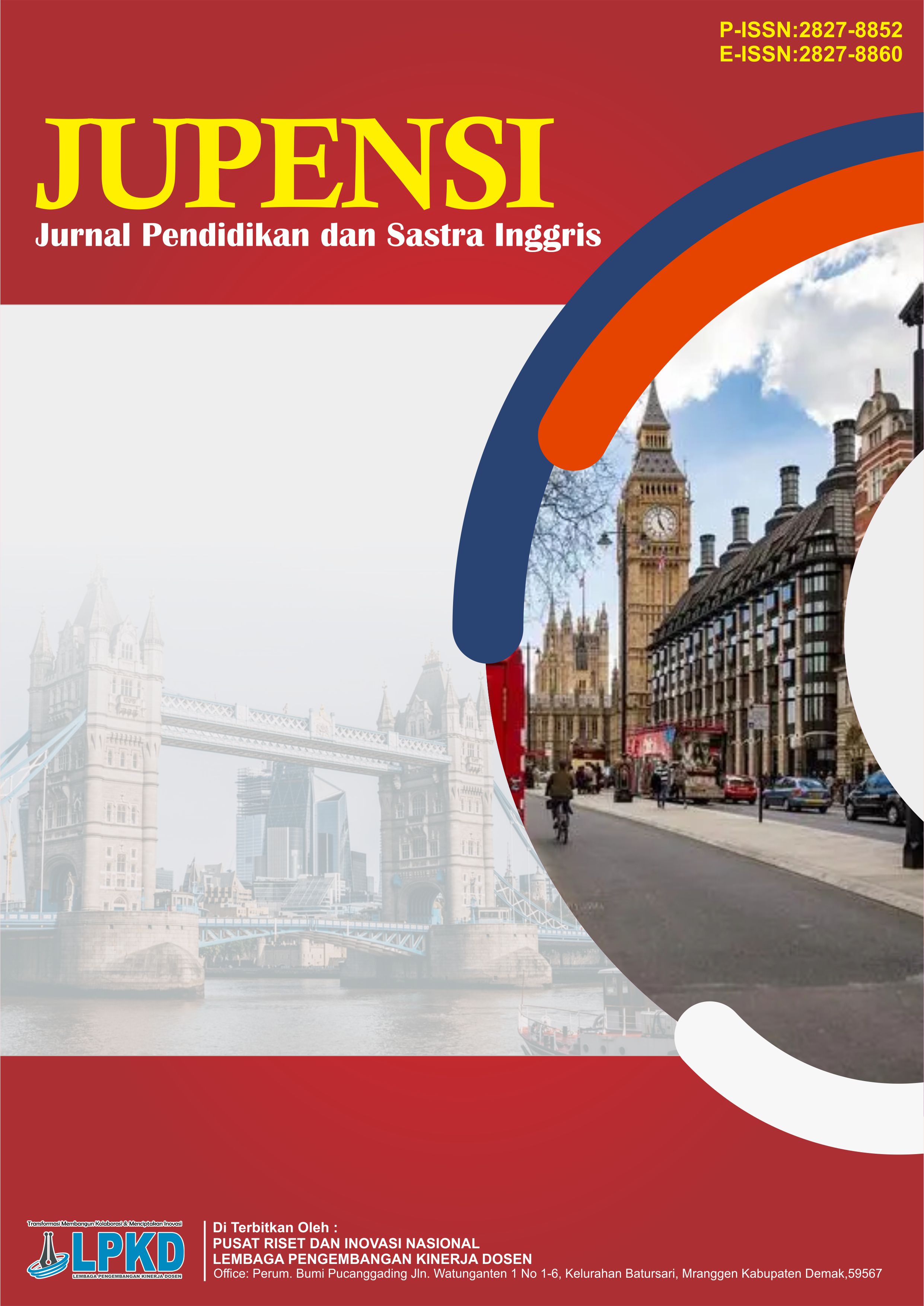An Investigation of ELT Students’ Preferences on the Use of Multimedia Resources in Extensive Listening Activities
DOI:
https://doi.org/10.55606/jupensi.v5i2.5615Keywords:
English Language Teaching (ELT), Extensive Listening, Learner Preferences, Listening Activities, Multimedia ResourcesAbstract
This study investigates the preferences of English Language Teaching (ELT) students regarding the use of multimedia resources in extensive listening activities. Utilizing a mixed-method approach with an Explanatory Sequential Design, the research combines quantitative descriptive statistics and qualitative thematic analysis to identify the most frequently used multimedia tools and the reasons behind students' choices. The participants consisted of 57 ELT students from Al-Qolam University.Findings reveal that songs and movies are the most preferred multimedia resources. These materials are favored due to their engaging nature and ability to blend entertainment with learning, which helps enhance vocabulary acquisition and improve pronunciation. The repeated exposure to authentic language in songs and movies contributes significantly to students’ listening comprehension and language development. Moderately preferred media include English lessons, game walkthroughs, vlogs, and podcasts, reflecting students' interest in diverse and real-world content. These types of multimedia offer practical language input in various contexts, although they are not as engaging as songs and movies for most students. In contrast, radio programs, sleep stories, and interviews were found to be the least preferred, primarily due to their lack of visual stimuli and perceived monotony, which leads to decreased engagement. Students’ reasons for their preferences were categorized into several key themes: personal interest, fun and entertaining learning experience, motivation to improve vocabulary, and enhanced pronunciation. These findings indicate that students are more likely to engage with and benefit from listening activities that align with their personal interests and offer enjoyable experiences. The study concludes that incorporating enjoyable and student-centered multimedia resources in listening activities can significantly improve motivation, engagement, and language outcomes. It highlights the need for educators to thoughtfully select multimedia materials that resonate with students’ interests to support more effective and meaningful language learning experiences.
Downloads
References
Ahmadpour, S., & Asadollahfam, H. (2018). A study of the effect of extensive and intensive listening on the tense use among EFL learners in Iran. The Journal of Applied Linguistics and Applied Literature: Dynamics and Advances, 6(2). https://doi.org/10.22049/jalda.2019.26383.1098
Bloomfield, A., Wayland, S. C., Rhoades, E., Blodgett, A., Linck, J., & Ross, S. (2010). What makes listening difficult? Factors affecting second language listening comprehension. Fort Belvoir, VA: Defense Technical Information Center. https://doi.org/10.21236/ADA550176
Chakraborty, M. (2019). Impact of multimedia on learners’ engagement: An experimental study. Journal of Information and Computational Science, 9(10).
Creswell, J. W., & Creswell, J. D. (2018). Research design: Qualitative, quantitative, and mixed methods approaches (5th ed.).
Darmawan, D., Setiawati, P., Supriadie, D., & Alinawati, M. (2017). Penggunaan multimedia pembelajaran interaktif untuk meningkatkan keterampilan menulis English simple sentences pada mata kuliah basic writing di STKIP Garut. Pedagogia, 15(1), 109. https://doi.org/10.17509/pedagogia.v15i1.6576
Gunawan, M. H., Mandiri, I. C. P., Suherdi, D., Hanifa, E. S. D., & Gunawan, A. P. (2023). Exploring EFL students’ perceptions of the use of podcast/TED Talk in extensive listening class. Indonesian EFL Journal, 9(1), 43–52. https://doi.org/10.25134/ieflj.v9i1.7486
Hidayat, I. N. (2024). Increasing students’ motivation in learning English through song at elementary school. JADEs Journal of Academia in English Education, 5(1), 165–181. https://doi.org/10.32505/jades.v5i1.8516
Ivone, F. M., & Renandya, W. A. (2019). Extensive listening and viewing in ELT. TEFLIN Journal, 30(2), 237–256. https://doi.org/10.15639/teflinjournal.v30i2/237-256
Karagöz, B., İşcan, A., Baskin, S., & Irşi, A. (2017). Investigation of Turkish teacher candidates’ listening skills. Universal Journal of Educational Research, 5(5), 750–756. https://doi.org/10.13189/ujer.2017.050507
King, J. (2002). Using DVD feature films in the EFL classroom. Computer Assisted Language Learning, 15(5), 509–523. https://doi.org/10.1076/call.15.5.509.13468
Listiyaningsih, T. (2017). The influence of listening English song to improve listening skill in listening class. Academica: Journal of Multidisciplinary Studies, 1(1), 35–49. https://doi.org/10.22515/academica.v1i1.601
Listiyanti, E. P., & Listyani. (2023). Students’ challenges and strategies in extensive listening class. Asian Journal of Education and Social Studies, 45(2), 12–25. https://doi.org/10.9734/ajess/2023/v45i2978
Ludke, K. M., Ferreira, F., & Overy, K. (2014). Singing can facilitate foreign language learning. Memory & Cognition, 42(1), 41–52. https://doi.org/10.3758/s13421-013-0342-5
Ly, N. N., & Nga, N. T. (2020). An investigation into the effects of extensive listening on pre-intermediate learners’ English vocabulary learning at The Asian International School. Ho Chi Minh City Open University Journal of Science - Social Sciences, 10(1), 3–17. https://doi.org/10.46223/HCMCOUJS.soci.en.10.1.552.2020
Öztürk, D. T. (2020). Encouraging extensive listening in language learning. Language Teaching Research Quarterly, 14, 80–93. https://doi.org/10.32038/ltrq.2020.14.06
Pamuji, K. D., Waring, R., & Kurniawan, E. (2019). EFL teachers’ experiences in developing L2 proficiency through extensive listening. TEFLIN Journal, 30(2), 257–273. https://doi.org/10.15639/teflinjournal.v30i2/257-273
Renandya, W. A. (2012). Materials and methods for extensive listening. A Journal on Language and Language Teaching, 2, 1–7.
Renandya, W. A., & Farrell, T. S. C. (2011). “Teacher, the tape is too fast!” Extensive listening in ELT. ELT Journal, 65(1), 52–59. https://doi.org/10.1093/elt/ccq015
Setyawan, D., Ivone, F. M., & Suryati, N. (2022). Learners’ preferences of multimedia resources in an extensive listening program. LLT Journal, 25(1), 23–37. https://doi.org/10.24071/llt.v25i1.3690
Ulum, Ö. G. (2015). Listening: The ignored skill in EFL context. International Journal of Humanities Social Sciences and Education, 2(5), 72–76.
Waring, R. (2011). Extensive reading in English teaching. In Innovation and creativity in ELT methodology (pp. 2–14).
Zulfikar, Z., Aulia, C. T., & Akmal, S. (2020). Exploring EFL students’ problems in listening to English news broadcasts. Language Literacy: Journal of Linguistics, Literature, and Language Teaching, 4(2), 340–352. https://doi.org/10.30743/ll.v4i2.2940
Downloads
Published
How to Cite
Issue
Section
License
Copyright (c) 2025 Jurnal Pendidikan dan Sastra Inggris

This work is licensed under a Creative Commons Attribution-ShareAlike 4.0 International License.









